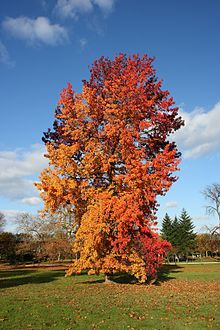Liquidambar

Liquidambar, commonly called sweetgum[2] (star gum in the UK),[3] gum,[2] redgum,[2] satin-walnut,[2] or American storax,[2] is the only genus in the flowering plant family Altingiaceae and has 15 species.[1] They were formerly often treated in Hamamelidaceae. They are native to Southeast and east Asia, western Mediterranean and eastern North America. They are decorative deciduous trees that are used in the wood industry and for ornamental purposes.
Both the scientific and common names refer to the sweet resinous sap (liquid amber) exuded by the trunk when cut.
They are all large, deciduous trees, 25–40 metres (82–131 ft) tall, with palmately 3- to 7-lobed leaves arranged spirally on the stems and length of 12.5 to 20 centimetres (4.9 to 7.9 in), having a pleasant aroma when crushed. Their leaves can be many colors such as bright red, orange, yellow, and even purple.[4] Mature bark is grayish and vertically grooved.[4] The flowers are small, produced in a dense globular inflorescence 1–2 centimetres (0.39–0.79 in) diameter, pendulous on a 3–7 centimetres (1.2–2.8 in) stem. The fruit is a woody multiple capsule 2–4 centimetres (0.79–1.57 in) in diameter (popularly called a “gumball”), containing numerous seeds and covered in numerous prickly, woody armatures, possibly to attach to fur of animals. The woody biomass is classified as hardwood.
L. styraciflua inflorescences on stem
At higher latitudes, Liquidambars are among the last of trees to leaf out in the spring, and also among the last of trees to drop its leaves in the fall/autumn, turning multiple colors. Fall/autumn colors are most brilliant where nights are chilly, but some cultivars color well in warm climates.
